Summary 
Handsome production features solid performances from a veteran Chicago cast, but there is little dramatic tension to be found in Shakespeare's late historical drama, despite the recurrence of an upstage fires-of-hell image that consumes the vanquished. A rock-star Henry in goatee and black leather mostly indulges his vanity and libido in subduing an unctuous Cardinal Wolsey and a wonderfully nuanced and hopelessly-in-love Queen Katherine.
Design
Directed by Barbara Gaines. Scenic design by James Noone. Costume design by Mariann S. Verheyen. Lighting design by Anne Militello. Original music and sound design by Lindsay Jones.
Cast
Mike Nussbaum (Suffolk), David Lively (Norfolk), Andrew Long (Buckingham/Cranmer), Scott Jaeck (Wolsey), Samuel Taylor (Cromwell), Gregory Wooddell (Henry), Ora Jones (Katherine), Kevin Gudahl (Surveyor/Griffith/Thomas More), William Dick (Lovell), Christina Pumariega (Anne Boleyn), David Darlow (Cardinal Campeius), Lance Baker (Gardiner), Kate Buddeke (Old Lady), Hilary Horvath (Jane Seymour).
Analysis
Barbara Gaines begins her handsomely created take on Henry VIII at Chicago Shakespeare Theater's lakefront space with a revealing prologue: Wolsey leads a procession of choral-chanting clerics in scarlet robes through the audience to the stage. Hanging from upstage is a white banner with "Henry VIII" written across it in elegant black script. With a pompous flourish, Scott Jaeck's Wolsey removes his flowing red robe and watches as it is hoisted over the King's banner, a golden crucifix at the center of the scarlet cloth. After venerable Chicago stage veteran Mike Nussbaum delivers a poignant Chorus introduction, Gaines begins 1.1 with Jaeck's Wolsey using a snuff box with pretentious flair, then holding out his hand in expectation for it to be kissed. When he waddles off in an unctuous exit, Buckingham angrily yanks the red banner from its moorings.
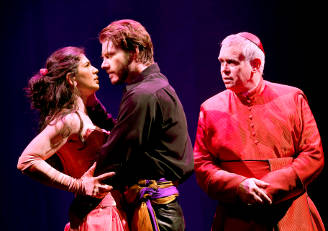
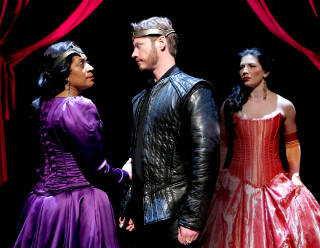
Gaines bookends a pair of revealing scenes involving the dancing royal couple around the fall of Buckingham. First, Henry and Katherine dance 1.2 in almost slow motion with one another, each gazing with adoration into the other's eyes, he a cocky lean rock star in black leather, longish brown hair and goatee, she more matronly in a royal purple gown but a gentle expressiveness. Gaines interrupts to show the arrest of Buckingham as he is marched upstage in manacles. The stage opens to reveal a daunting furnace-like contraption with doors that open to show crackling red and yellow flames as if the entrance to hell. Amid billowing fog, Buckingham falls and shouts, then rolls into the flickering light as if being drawn into the flames, and after the sound of a metal door slamming shut, the lights fade to black. Gaines returns to a hand-in-hand Henry and Katherine 1.4, a moody piano score highlighting the end of a romantic moment as Henry's eye wanders - "what fair lady's that?" - and he drifts away from Katherine to dance with the younger Anne Boleyn in soft pink lighting, even giving his new love a ring.
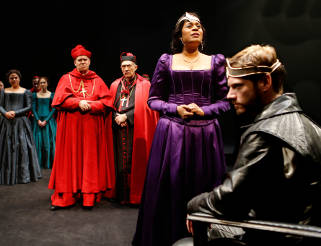
Ora Jones's Katherine is the highlight of the production, a poignant portrayal of a once proud and beautiful woman struggling to maintain her dignity after being rejected by the King she still loves. Jones's Katherine flashes hot temper, a sense of loss like a physical sickness, and a softly-spoken acceptance, often in alternating mood swings within the same scene. By 2.3 the sultry Anne has proven herself in charge of Henry's court, issuing clipped commands, and the subdued Katherine maintains her eloquence - and most of her dignity - during 2.4, despite Henry's exasperated rejection: "go thy ways, Kate!" By 3.1, Jones's Katherine loses control, flatly begging a maddeningly triumphant Wolsey, having to be seized by the arms, then collapsing to grovel and grasp Campeius by a shoe. Her fall from power is signaled by her slowly moving upstage to the fiery furnace as the production pauses for intermission.
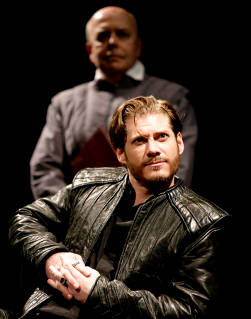
The second half begins with a sexy scarves dance, an insight into the nature of Henry's choices, and Gaines focuses the first scenes on the confrontation with Wolsey. Gregory Wooddell's rakish Henry continues to wear black leather 3.2, strutting with can-do-no-wrong pop god cool, as people make observations about him - "observe, observe, he's moody" - and about his chosen wife: "with her will fall some blessing to this land." Wooddell's supremely confident King seems under-matched by the disingenuous Wolsey - "his thinkings are below the moon" - and so the battle of wits seems grossly one-sided and therefore lacking real drama. The combatants go through motions - "you are full of...heavenly stuff!" - toward the obvious conclusion of Henry's victory. Wooddell's Henry puffs with sarcasm - "take notice, lords, he has a loyal breast" - as Jaeck's corpulent Wolsey rapidly deflates, lunging into the arms of his supporters for a moment's comfort before staggering upstage: "I'd rather lack those than my head." Jaeck's big moment - "farewell to all my greatness" - is well-performed, certainly, but the character never inspires sympathy and his fall from grace has seemed imminent, so a more reflective approach like a calm realization would perhaps have worked better dramatically than Jaeck's Wolsey's angry shouting - "vain pomp and glory of this world, I hate ye!" - and staggering with symptoms from a heart attack. His defiant Wolsey - "never to hope again" - does not welcome the looming fire that now crackles again upstage in flickering stage fog, but defies it, almost rushing and jumping into the pulsating red and orange light.
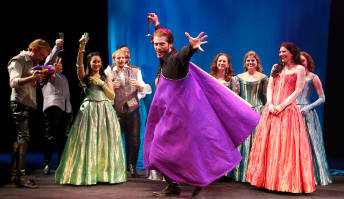
Gaines counterpoints a stately 4.1 coronation, Anne resplendent in golden gown moving among white cushions with her orb and scepter, with the 4.2 fade of Katherine. The latter is the production's finest scene - beautifully acted and insightful - with Jones's Katherine nearing her end, her hair down, wearing a robe, reclining among her servants, surrounded by flickering white candles. She shows a quite human satisfaction with Wolsey's demise - "tell me how he died" - talking with her attendants, who sit and knit at each corner of the stage. Katherine begins to doze, and Gaines fills the stage with an emotional dream sequence, as the former Queen rises to meet the handsome Henry upstage, then dance beautifully with him, swirling across the stage to complete their romantic dance with a long and loving kiss. When the music stops, Henry backs away with a smile, and the curtains close on Katherine.
With Wolsey and Katherine dispatched, Shakespeare's story has nowhere very dramatic left to go, and Gaines focuses Act 5 on the birth of Elizabeth. First, a creepy Bishop Gardiner seems to make an attempt to fill the void left by Wolsey - demanding Sir Thomas Lovell kiss his ring 5.1 - and after a quick vignette of the heavily drinking father-to-be Henry playing cards upstage (and dancing giddily at the premature news of a boy), Gardiner finds his comeuppance 5.3. With Cranmer facing an upstage tribunal of six clerics after being arrested, he reveals the King's ring - and its implied protection - to them, and is then embraced one by one ("God, man, sit down!"), lastly by a reluctant Gardiner in a half-hearted sideways man-hug.
Nussbaum's Chorus finishes the smart and elegantly realized, if not very dramatic, history with a humor-filled narration, slapping a young maid on the bottom, then Cranmer leads a 5.5 procession from the rear of the audience. The court and observers all cheer as the young princess is announced - "Elizabeth!" - and a burst of glittering confetti slowly twirls down onstage and onto the audience. In a revealing closing vignette Henry notices an attractive young girl with long blonde hair, and as Anne watches in outrage from extreme stage right, Henry shoots his wife a bemused but knowing glance before kissing the young girl. Wooddell's randy Henry then gives a leer and follows the girl offstage as Anne watches in horror, then slowly - and with some guilt-ridden acceptance, perhaps - walks upstage as the furnace begins to fire, lighting upstage as fog again begins to roil.